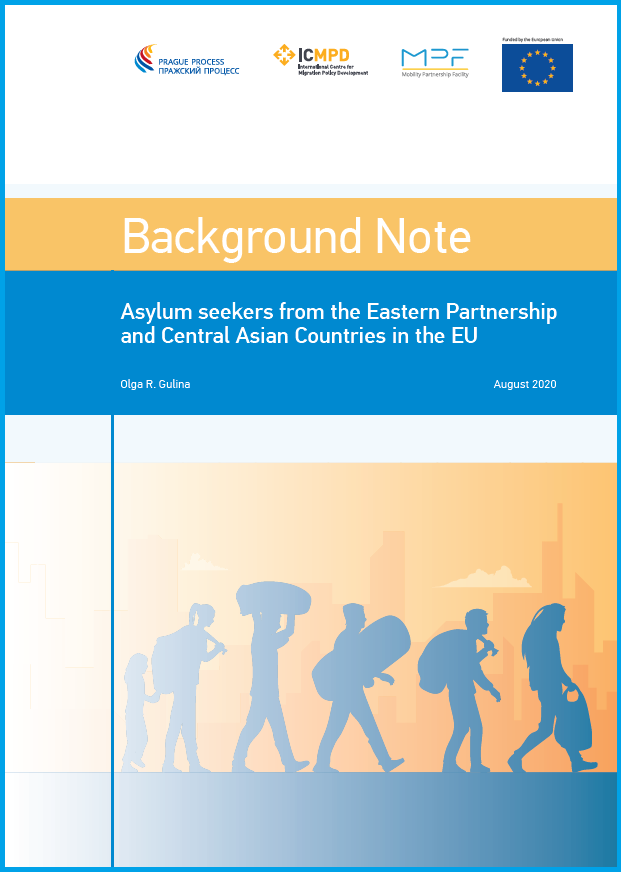The past 30 years have seen several waves of asylum seekers from the post-Soviet region reaching the EU, including from the Central Asian (CA) and Eastern Partnership (EaP) countries. Their relatively small numbers resulted in limited attention by the research community. Yet, in 2018, asylum seekers from the two regions accounted for over 7% of all first-time asylum applicants in the EU. The extremely low recognition rate of asylum applications and the broad demographic profile among asylum seekers from the eight countries examined suggests that they actually abuse the EU asylum system to improve their socioeconomic situation. The witnessed mixed flows of forced and voluntary migration from the EaP and CA states challenge the efficiency of the EU asylum and international protection system. Several aspects deserve particular attention in this respect: the inclusion of the CA and EaP countries in the lists of safe countries of origin (SCO), resulting in accelerated asylum procedures; and the need for proper awareness-raising about regular migration channels to the EU MS.
The new Background Note 'Asylum seekers from the Eastern Partnership and Central Asian Countries in the EU' authored by Dr. Olga R. Gulina and released by the Prague Process Migration Observatory provides a statistical overview on the inflows, demographic indicators and recognition rates of asylum seekers coming to the European Union, focusing on eight countries of origin, located in the Eastern Partnership and Central Asia region: Moldova, Ukraine and Georgia, as well as Kazakhstan, Kyrgyzstan, Uzbekistan, Turkmenistan and Tajikistan. The document entails evidence on the socio-economic and political push factors behind these flows and the policy context they are embedded in. Particular attention is given to the classification of these countries as so-called ‘safe countries of origin’, in spite of the ongoing or frozen territorial conflicts suffered by some of them. Several conclusions and recommendations are drawn at the end.
To preview and download the Note please use this link.
Moreover, our Repository
- Policy brief by Glen Hodgson "Migration and the Platform Economy"
- Policy brief by Stefan Vogtenhuber "Labour migration from East to West: The example of foreign workers in Austria"
- Policy brief by Haykanush Chobanyan "Armenia's migration cooperation with the European Union and Eurasian Economic Union"
- Policy brief by Rainer Muenz "How will migration to Europe look in the Future? Trends, open questions and four plausible scenarios"
- Policy brief by Ruslan Minich and Pavlo Kravchuk "The Impact of COVID-19 on Ukrainian Labour Migrants in Czechia, Hungary, Poland and Italy"
- Policy brief by Glen Hodgson "Intra-corporate Transferees (ICTs): The benefits for the EU and the opportunity cost"
- Policy brief by Kristof Tamas "Making the EU’s Migration and Development Policies More Coherent"
- Policy brief by Andriy Orlean "Countering Human Trafficking: Identifying, Returning and Assisting Victims from Ukraine"
- Policy brief by Olga Gulina "Russian nationals looking for refuge in the European Union"
- Policy brief by Dmitry Poletaev "Russia’s Migration Policies after the dissolution of the Federal Migration Service"
- Policy Brief by Yan Matusevich "The EU Central Asia Strategy and Its Impact on Migration"
- Policy brief by Kristof Tamas "Assessing the EU's External Migration Policy"
- Training Manual "How to be a good trainer?"
- Policy Brief by Nermin Oruc and Danica Santic "Highly-skilled Return Migrants to the Western Balkans: Should we count (on) them?"
- Analytical Report by Yelena Sadovskaya "China's "Belt and Road" Initiative and Its Impact on Migration Flows and Policies in Central Asia"
- Policy Brief by Petros Aghababyan "Closing the policy gaps concerning an eventual mass influx of asylum seekers to Armenia"
- Policy Brief by Yan Matusevich "Evaluating the Future of Uzbek Labour Migration"
- Analytical Report by Ivanka Heinzl "Report on the National Action Plan to Fight Trafficking in Human Beings of the Republic of Azerbaijan"
- Policy Brief by Haykanush Chobanyan "Assessing Armenia’s Migration Strategy for 2017-2021"
- Policy Brief by Natia Mestvirishvili "Circular Migration Schemes in Georgia"
- Policy Brief by Katerina Ivashchenko-Stadnik "Ukraine: First visa-free year since introducing the visa-free regime"

